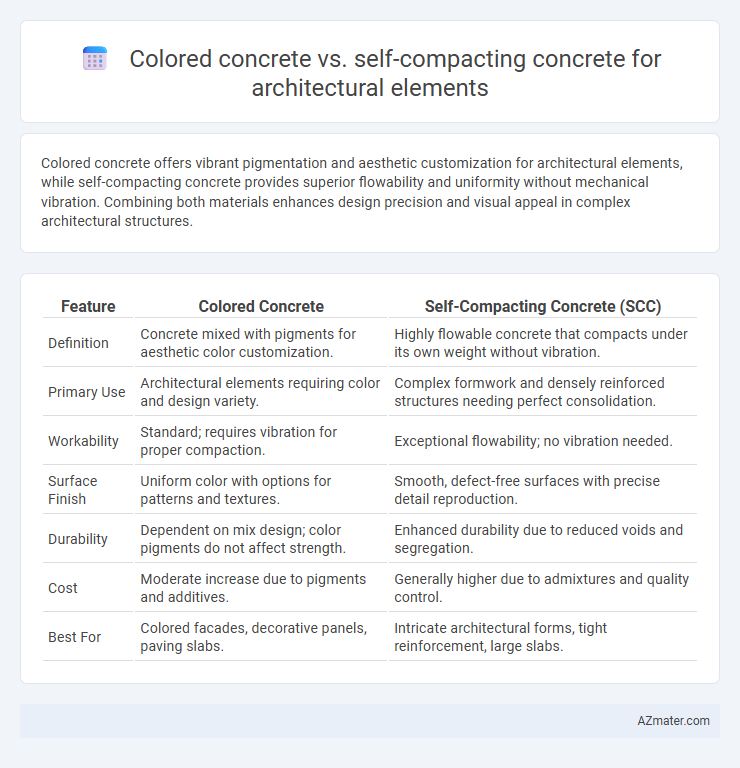Colored concrete offers vibrant pigmentation and aesthetic customization for architectural elements, while self-compacting concrete provides superior flowability and uniformity without mechanical vibration. Combining both materials enhances design precision and visual appeal in complex architectural structures.
Table of Comparison
| Feature | Colored Concrete | Self-Compacting Concrete (SCC) |
|---|---|---|
| Definition | Concrete mixed with pigments for aesthetic color customization. | Highly flowable concrete that compacts under its own weight without vibration. |
| Primary Use | Architectural elements requiring color and design variety. | Complex formwork and densely reinforced structures needing perfect consolidation. |
| Workability | Standard; requires vibration for proper compaction. | Exceptional flowability; no vibration needed. |
| Surface Finish | Uniform color with options for patterns and textures. | Smooth, defect-free surfaces with precise detail reproduction. |
| Durability | Dependent on mix design; color pigments do not affect strength. | Enhanced durability due to reduced voids and segregation. |
| Cost | Moderate increase due to pigments and additives. | Generally higher due to admixtures and quality control. |
| Best For | Colored facades, decorative panels, paving slabs. | Intricate architectural forms, tight reinforcement, large slabs. |
Introduction to Colored Concrete and Self-Compacting Concrete
Colored concrete integrates pigments into the mix, enhancing architectural elements with vibrant, durable hues while maintaining structural integrity. Self-compacting concrete (SCC) is engineered for high fluidity and workability, allowing it to flow easily into complex molds without mechanical vibration, ideal for intricate architectural designs. Both materials optimize aesthetics and performance, with colored concrete emphasizing visual appeal and SCC focusing on ease of placement and detailed form reproduction.
Material Composition and Properties
Colored concrete incorporates pigments such as iron oxide, titanium dioxide, or synthetic dyes directly into the cement mix, resulting in vibrant, uniform hues while maintaining standard compressive strength and durability. Self-compacting concrete (SCC) features a highly flowable mix design with superplasticizers and viscosity-modifying agents, enabling it to fill intricate architectural forms without mechanical vibration, enhancing surface finish quality. The distinct material compositions influence workability and aesthetics; colored concrete prioritizes pigmentation consistency, whereas SCC emphasizes fluidity and segregation resistance for complex architectural elements.
Aesthetic Flexibility and Design Options
Colored concrete offers a vast palette of vibrant hues and customizable pigments, enhancing architectural elements with precise color matching and patterns that elevate aesthetic flexibility. Self-compacting concrete enables intricate mold designs and smooth, defect-free surfaces due to its high flowability, supporting complex shapes and fine detailing in architectural features. Combining both materials allows architects to achieve unique design options through seamless integration of vivid colors and sophisticated textures, redefining aesthetic possibilities.
Workability and Placement Techniques
Colored concrete offers excellent workability with easy integration of pigments, allowing consistent hue distribution during placement. Self-compacting concrete (SCC) excels in workability due to its high flowability and ability to fill complex molds and intricate architectural elements without vibration. Placement techniques for colored concrete rely on conventional methods like screeding and troweling, while SCC requires careful mix design and controlled pouring to maintain uniformity and prevent segregation.
Surface Finish and Texture Considerations
Colored concrete offers vibrant, customizable hues that enhance architectural elements with uniform pigmentation, while maintaining a traditional surface finish ideal for exposed aggregate textures and intricate formwork patterns. Self-compacting concrete excels in achieving smooth, flawless surfaces due to its high flowability and ability to fill complex molds without vibration, resulting in consistent texture and reduced surface defects. Choosing between the two depends on the desired aesthetic: colored concrete prioritizes pigmentation and surface texture variety, whereas self-compacting concrete emphasizes seamless finish quality and textural precision.
Durability and Weather Resistance
Colored concrete offers excellent durability and weather resistance due to its integral pigmentation, which prevents fading and surface degradation over time. Self-compacting concrete enhances durability through its dense, homogeneous matrix that reduces permeability and resists freeze-thaw cycles in architectural elements. Both materials provide superior longevity, but self-compacting concrete specifically excels in minimizing micro-cracking, contributing to increased resilience in harsh environmental conditions.
Structural Strength Comparison
Colored concrete incorporates pigments within the mix, maintaining its inherent structural strength similar to standard concrete, suitable for architectural elements requiring both aesthetic appeal and durability. Self-compacting concrete (SCC) offers superior flowability and compaction without mechanical vibration, which enhances uniformity and reduces the risk of voids, leading to increased structural integrity in complex shapes or densely reinforced architectural components. When comparing structural strength, SCC generally provides improved compressive strength and durability due to its optimized particle packing and reduced segregation, whereas colored concrete must carefully balance pigmentation levels to avoid compromising mechanical properties.
Cost Analysis and Project Budgeting
Colored concrete enhances architectural elements with vibrant aesthetics but typically incurs higher material and pigment costs, impacting project budgeting. Self-compacting concrete reduces labor expenses and accelerates construction timelines by eliminating vibration, offering cost savings despite slightly higher mix design prices. Balancing initial material costs against labor efficiency and desired finish quality is crucial for accurate cost analysis in architectural projects.
Sustainability and Environmental Impact
Colored concrete reduces the need for surface treatments and coatings, lowering volatile organic compound (VOC) emissions and enhancing durability, which minimizes maintenance and resource consumption. Self-compacting concrete improves material efficiency by eliminating the need for vibration, reducing labor and energy, while its optimized mix design can incorporate recycled materials and supplementary cementitious substances to decrease the carbon footprint. Both options contribute to sustainable architectural elements by promoting longevity and minimizing environmental impact through thoughtful material selection and application techniques.
Choosing the Right Concrete for Architectural Elements
Colored concrete offers vibrant, customizable hues ideal for decorative architectural elements, providing aesthetic flexibility and long-lasting color retention. Self-compacting concrete enhances structural integrity and surface smoothness by flowing easily into complex formwork without vibration, making it perfect for intricate architectural shapes. Selecting the right concrete depends on the desired balance between visual appeal and ease of placement for detailed architectural components.

Infographic: Colored concrete vs Self-compacting concrete for Architectural element
 azmater.com
azmater.com